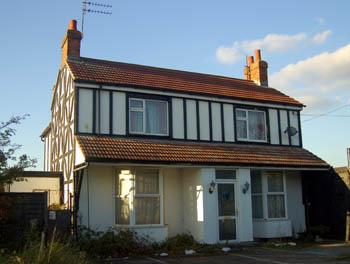The Brickmakers Arms Public House Kempston Hardwick

The Brickmakers Arms October 2007
The Brickmakers Arms Beerhouse [also The Red Beerhouse and The Halfway Beerhouse]: Woburn Road, Kempston Hardwick
This Halfway Beerhouse formed part of the Kempston Hoo Estate. The countywide licensing register of 1876 states that an unnamed beerhouse belonging to Mrs. Barnard, owner of the estate, and tenanted by Charles Whitbread was first licensed in 1847. Whitbread was still there at the time of the countywide register of 1891, by which time the owner was Jarvis and Company, the Bedford brewers and the beerhouse is stated to be on the Marston Road.
Jarvis evidently acquired the property in 1884 when the Hoo Estate was put up for sale. Lot Three was "a Compact Small Property known as "THE RED OR HALFWAY BEER HOUSE" well situate for trade, by the side of the Bedford and Woburn Road". The accompanying map makes it clear that this is the later Brickmakers.
The beerhouse is described as a "conveniently-arranged house" and comprised a parlour, a tap room, a kitchen, a cellar and three bedrooms. At the rear stood a barn, a stable, a coal house, piggeries and a small enclosure of pasture land comprising two acres, three roods, twenty nine poles. It was let to Jarvis and Company for £20 a year. The map shows that the property stood on the west side of the road because today's layby was then the course of the main road.
Today [2013] the property lies just inside the modern parish boundary of Stewartby and thus forms part of Kempston Hardwick. Bedfordshire & Luton Archives & Records Service does not have much other material in the way of records for the Brickmakers Arms. Charles Wells took Jarvis and Company over in 1910 and the beerhouse became fully licensed on 1st March 1951 [PSB9/2].
In 1927 Bedfordshire was valued under the Rating Valuation Act 1925; every piece of land and building was valued to determine the rates to be paid on it. The valuer discovered the accommodation consisted of a sitting room, parlour (or tap room), kitchen and cellar downstairs with 3 bedrooms above and outside an earth closet, barn ["big"], stable for two horses, scullery and two "little stores". Trade was not brisk at only one barrel and a dozen bottles of beer per week. The beerhouse stood in 2.613 acres. The valuer was not impressed, noting: "Miserable situation & house no cottages &c. near".
The public house closed in the mid 1990s and became a private house. It lies at the end of a long lay-by on the busy A421 until the relief road was built and opened in the winter of 2010 when the road became considerably less busy! At the time of writing [2011] the property is derelict.
Sources:
- Z808/3/1: sale particulars: 1884;
- PSB9/1: register of licenses: 1903-1935;
- PSB9/2: register of licenses: c.1955-1995;
- Z1105/1: liquor licence traders survey form: 1960
List of Licensees: note that this is not a complete list. Italics indicate licensees whose beginning and/or end dates are not known:
1851-1864: George Church, farmer, agricultural labourer and publican, Up End or Marsh Leys;
1876-1891: Charles Whitbread;
1903-1904: Thomas Copperwheat;
1904-1906: Thomas Giggle;
1906-1912: George William Copperwheat;
1912-1913: Harry Miller;
1913-1915: Arthur Perry;
1915-1936: Albert Deadman;
1940: William Bain;
1960-1975: Leslie Simeon Linsell;
1975-1976: Allan Irwin Preston;
1976-1980: Maurice Graham Oliver;
1980-1982: Patrick John Munnelly;
1982-1991: Patrick Anthony Lennon;
1991-1993: Jeanette Rosalie Palmer;
1993: Paul Elystan White-Archer